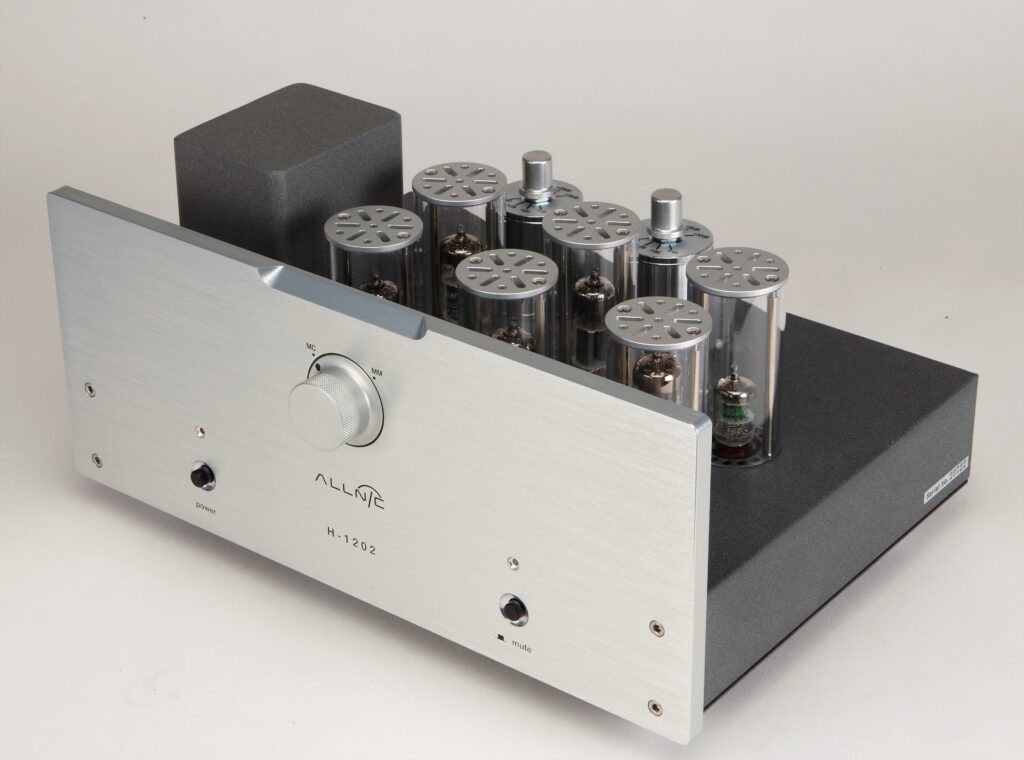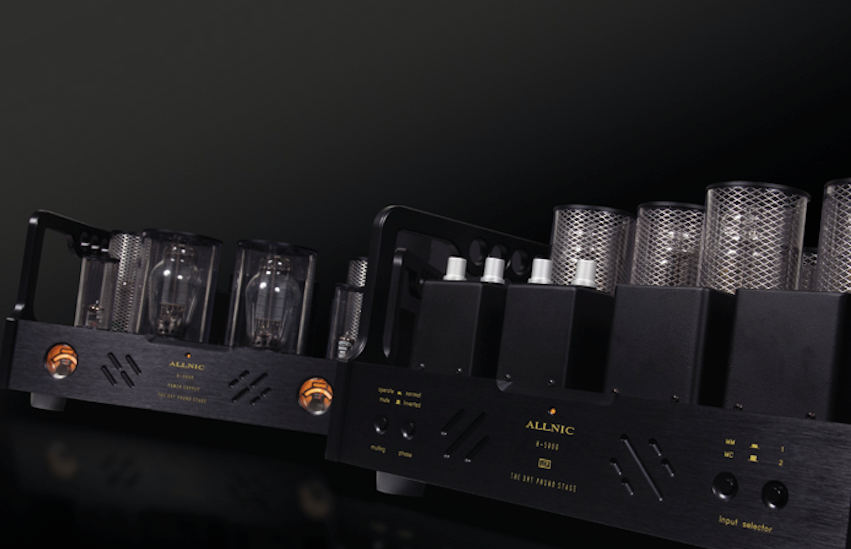Today we are proudly announcing the birth of moving coil cartridge sisters AMBER and ROSE.…

Allnic H-1202 Phono-stage
The H-1202: Allnic’s Over-Achieving “Baby” Phono Preamp
– And a “Little” History
If you have been following Allnic Audio for any time, you’ll already know that it manufactures a full line of phono preamplifiers that are spectacular for both sound quality and price to performance ratio. These currently range from the exceptionally popular and exceptional sounding, easy to use H-1202 to the “all stops pulled”, direct-heated triode H-8000, a true triumph of audio engineering. All these devices use the same MC step-up transformers!
AUT-2000 Step-Up Transformers

H-1202

H-1500II

H-7000 and H-7000V
 H-8000
H-8000

The Original: The H-1200

Allnic’s first entry into the North American and European markets for phono preamps, ‘way back in 2007, the H-1200, was an unassuming looking little rectangular box, measuring only 112mm (4.4 inches) wide, 250mm (9.8 inches) deep, and 93mm (3.67 inches) high. What turned out to be a very, very high performance unit (despite not being a CR or LCR type) for its price, this 4 tube “shrimp” weighed all of 2.2 Kg (just under 5 Lbs) and cost $1,600 USD.
Like the amazingly overachieving L-1500 preamp (see the end of this blog), the H-1200 confirmed Hammertone’s desire to represent Allnic.
The price to performance ratio was incredible. Hammertone wasn’t alone in this view, and you can find a number of forums on-line discussing this “entry-level” phono-stage with great enthusiasm. Here’s what 6moonsthought about the H-1200: https://6moons.com/audioreviews/allnic2/phono.html
Unfortunately, though the H-1200 was selling extremely well in North America and Europe, especially for a unit manufactured by a company not really known outside Asia at the time, its long and successful production run finally ended in 2010 in the middle of the 6moons review. Allnic had decided to focus strictly on CR and LCR analog devices, KS Park’s specialty (*See the NOTE at the end of this blog on different de-emphasis methods for RIAA).
The AUT-2000
 The AUT-2000, a stand-alone, two channel step-up transformer was first released around the time of the H-1200. It is the simplest of the Allnic MC amplification devices, and unlike the others it does not need a power supply; it is simply a pair of the MC Step-up transformers used in Allnic’s phono preamps, one for each channel. After all these years, it is still a current product at $2100, with equally good news being that all the current production uses the same MC step-up transformers as the other Allnic phono amplification devices, including the ultra-high end H-8000. The AUT-2000 is easy to use with any MC cartridge – and a bargain at its price to performance point.
The AUT-2000, a stand-alone, two channel step-up transformer was first released around the time of the H-1200. It is the simplest of the Allnic MC amplification devices, and unlike the others it does not need a power supply; it is simply a pair of the MC Step-up transformers used in Allnic’s phono preamps, one for each channel. After all these years, it is still a current product at $2100, with equally good news being that all the current production uses the same MC step-up transformers as the other Allnic phono amplification devices, including the ultra-high end H-8000. The AUT-2000 is easy to use with any MC cartridge – and a bargain at its price to performance point.

hi>fi+:
http://www.hifiplus.com/articles/allnic-aut-2000-step-up-transformer/
The Absolute Sound:
http://www.theabsolutesound.com/articles/allnic-aut-2000-step-up-transformer/
HiFi Wigwam:
https://www.hifiwigwam.com/alnic-aut-step-up-transformer-review/
Mono & Stereo:
https://www.monoandstereo.com/2014/08/allnic-puritas-boron-and-aut-2000-mc.html
The H-1201
 The H-1201, introduced in early 2010, was a very different beast from the H-1200 but retained the excellent price/performance ratio. Initially priced at $2,950 ($3,450 at the end of production), the CR type H-1201 was, until replaced by the current H-1202, one of Allnic’s top sellers. Here’s a sampling of the enthusiastic reviews:
The H-1201, introduced in early 2010, was a very different beast from the H-1200 but retained the excellent price/performance ratio. Initially priced at $2,950 ($3,450 at the end of production), the CR type H-1201 was, until replaced by the current H-1202, one of Allnic’s top sellers. Here’s a sampling of the enthusiastic reviews:

Dagogo:https://www.dagogo.com/allnic-h-1201-phono-stage-review/
Enjoy the Music: http://www.enjoythemusic.com/magazine/equipment/0114/allnic_h_1201.htm
The Audio Beat: http://www.theaudiobeat.com/equipment/allnic_audio_h1201.htm
Hi-Fi Wigwam:https://www.hifiwigwam.com/allnic-h-1201-phono-stage-review/
Australian hi-fi: https://www.avhub.com.au/product-reviews/hi-fi/allnic-audio-h-1201-phono-eq-amplifier-review-399851
Australian hi-fi lab test: http://i.nextmedia.com.au/Assets/AHF_Nov15_Allnic_H-1201.pdf
In 2018, Hammertone offered a free NOS tube replacement for all owners of the H-1201. How many dealers do that!?
The H-1202

In 2018, the H-1201 was replaced by the current model H-1202. The primary differences between the 1201 and the 1202 are the use in the 1202 of vacuum tube voltage regulation and improved step-up transformers. Those transformers are the same as used in the $39,000 H-8000, the $14,900 H-7000, and the $7500 H-1500II. With these upgrades, the 1202 offers much higher performance than the 1201 at only $3,750, including FREE SHIPPING to anywhere in North America.

This is still a very cost effective way to bring the Allnic sound into your own living room and grab a large slice of the magic of the amazing H-1500II, H-7000 and H-8000 phono-stages. Like all Allnic products, it will trade blows in the marketplace with far more expensive competitors. More dynamic, open, and real sounding, with lots of air and space, than the H-1201, Allnic’s current entry level phono preamp gets even closer to its bigger siblings than the H-1201 did, at what has to be considered a virtual giveaway price.
Don’t take our word for it… read the reviews:
AUDIOPHILIA:

THE AUDIO BEAT:
http://www.theaudiobeat.com/equipment/allnic_audio_h1202.htm
LOTUS HIFI (UK ALLNIC DEALER):
And more still to come.
Looking forward to reading YOUR reviews!!
BTW, there are now just a few of the fantastic L-1500 line-stage preamps with the L-7000 transformer/new remote upgrades left! (See the November 2019 blog). $4700, including free shipping in North America.

A great match with the H-1202! Last chance – don’t lose out!
When they’re gone, they’re GONE.
The H-1202 and all other Allnic electronics are available from:
CANADA:

Hammertone Audio
We do trades!
Kelowna, BC
Website link: Hammertone Audio
Email or call Dave Beetles:
Email: [email protected]
Tel:+1 250.826.6872
Corby’s Audio
Freelton, Ontario
Website link: Corby’s Audio
Email or call Don Corby:
Email: [email protected]
Tel: +1 905.689.1976
Toll free: 1.877.689.1976
USA:
Kevalin Audio
Portland, Oregon
Website link: Kevalin Audio
Email or call John Ketcham:
Email: [email protected]
Tel: +1 503–292–5592
Porterhouse Audio
Dallas, Texas
Website link: Porterhouse Audio
Email Albert Porter
Email: [email protected]
To arrange for purchase and free shipping of any Allnic product to parts of the world where there is no Allnic representation, please contact Hammertone Audio.
*NOTE: RIAA De-emphasis Methods:
What do “CR” and “LCR” mean? Well, as you no doubt know, RIAA equalization is a specification for the correct playback of vinyl records, established by the Recording Industry Association of America. The purpose of the equalization is to permit longer playback times and improve sound quality.
RIAA equalization is a form of establishing a flat frequency response for the playback of recorded music. The necessity for this equalization process arises from mechanical difficulties inherent in record production. In order to prevent the cutting needle from over-cutting into the next record groove in the bass, as a record is cut, some bass frequencies are attenuated. In the treble region, in order for high frequency sounds not to be masked by the noise inherent in moving a stylus over and through a modulated vinyl surface, some treble frequencies are boosted. With the application of the correct filtering techniques on playback, the result is a flat frequency response with better signal to noise ratios.
There are four de-emphasis methods that can be applied at playback:
- Active filters (Negative feedback types):
Different quantities of negative feedback are applied, with deeper feedback to the high frequencies and shallower to the low frequencies. The benefits of this method are improved signal to noise ratios, low cost and consistent operation. Some of the shortfalls are looser bass reproduction and possibly a pinched and compressed high frequency playback due to excess feedback ratios.
- Passive filters (CR type):
The frequencies are filtered to fit the RIAA specification by varying the amount of attenuation at different frequencies through a complex capacitor-resistor network. This technique results in no voltage overload, purer reproduction (because there is no feedback), and more accurate RIAA compensation. However, there are problems because the system provides no gain, and insertion loss and impedance matching issues arise.
- Hybrid filters (use of both CR and negative feedback types):
In this method, both types of filters applied separately; an active filter is applied to the low frequencies and a passive filter to the high frequencies. Unfortunately, both the advantages and disadvantages of each of these two types of filters, already discussed, affect the playback system at the same time.
- LCR filters:
Two pieces of a linear reactor (a kind of choke coil) comprise the main part of these filters, assisted by precise CR filters, in order to lower impedances and insertion loss. In vacuum tube circuits, active and passive filters usually are operated on one hundred plus kilo ohms of impedance. An LCR RIAA filter’s impedance is a constant 600 ohms.
Furthermore, an LCR RIAA filter’s series resistance is less than 13 ohms (as a comparative, some famous ones are 31 ohms). The lower the impedance, the more dynamic is the sound reproduction, with better bass response and speed. But LCR RIAA units have drawbacks as well. These drawbacks are high cost and the difficulty of impedance matching; the latter has been the primary hindrance to the commercialization of this superb method in the construction of phono stage amplifiers. However, Allnic Audio manufactures extremely high quality LCR RIAA units and developed a 600 ohms impedance matching method.


